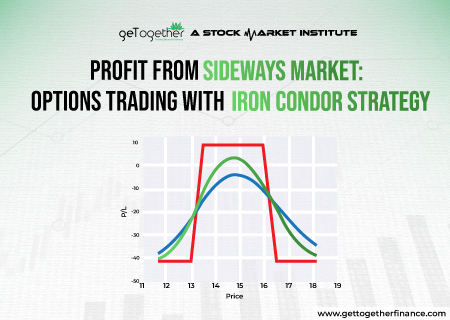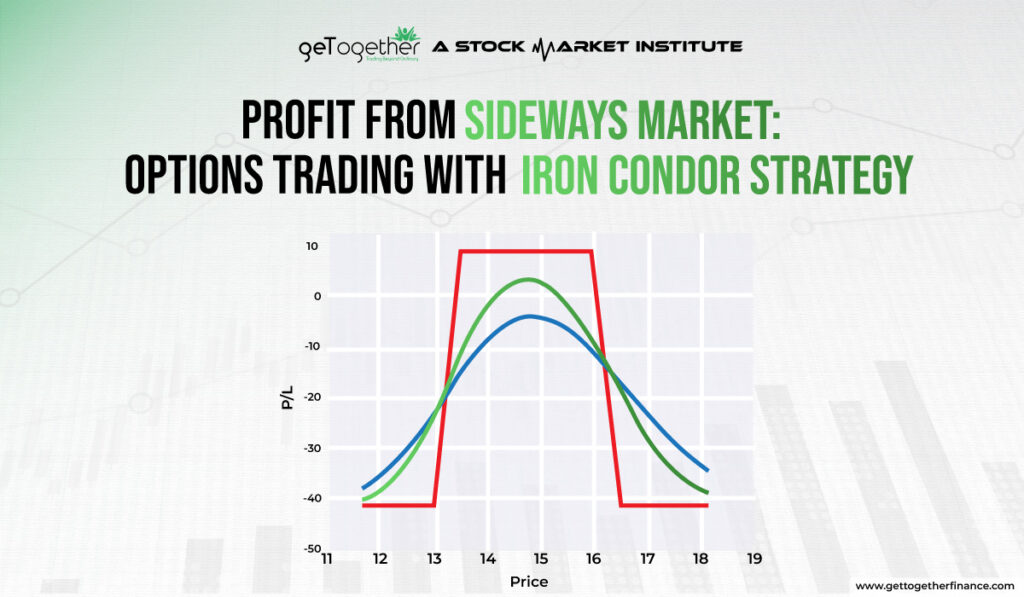Profit from Sideways Market: Options Trading with Iron Condor Strategy


Most stock market traders buy/sell options contracts, hoping a particular stock’s price will rise or fall. Unfortunately, this happens frequently, and the price barely moves.
The stock market’s unpredictability can be a double-edged sword for options traders. While it fuels potential profits from directional moves, it also wreaks havoc on strategies dependent on pronounced trends.
So, what happens when the bourses remain flat, and traders still want to make money?
Enter the Iron Condor strategy, a range-bound options trading strategy designed to thrive in uncertain market conditions.
Read this article as a guide, digging deep into the iron condor strategy and arming yourself with newfound confidence while negotiating the market’s choppy waters.
What Is an Iron Condor Strategy?
An iron condor is a directionally neutral options trading strategy that helps traders profit from relatively stable or sideways-moving stock markets. It aims to extract profits when the stock remains range-bound as the option’s expiration date inches closer.
The iron condor strategy is a four-legged approach that involves trading two call options (one long and one short) and two put options (one long and one short). All these trades happen at different strike prices but with the same expiration date.
Unlike directional plays that gamble on upward climbs or downward plunges, an iron condor capitalizes on the time decay of options premiums and a neutral or mildly volatile market. In such situations, the stock remains within a defined range, known as the “wings” of the condor.
Understanding an Iron Condor

The iron condor strategy can be executed in two fashions:
Long Iron Condor
It generates a net debit and involves the following trades:
- Purchase one out-of-the-money (OTM) put option with a strike price below the stock’s current trading price (Short). This OTM put will safeguard your capital against a considerable downside price movement of the stock.
- Sell one OTM put option with a strike price further below the stock’s current trading price (Long).
- Sell one OTM call option with a strike price above the stock’s current trading price (Short).
- Purchase one OTM call option with a strike price further above the stock’s current trading price (Long). This OTM call will safeguard your capital against a considerable upward price movement of the stock.
Here, a call option is OTM when its strike price exceeds the stock’s market price. Conversely, a put option is OTM when its strike price is lower than the stock’s market price.
Short Iron Condor
It generates a net credit and involves the following trades:
- Sell one in-the-money (ITM) put option with a strike price above the stock’s current trading price (Short).
- Buy one ITM put option with a strike price even further above the stock’s current trading price (Long).
- Sell one ITM call option with a strike price below the stock’s current trading price (Short).
- Purchase one ITM call option with a strike price further below the stock’s current trading price (Long).
Here, a call option is ITM when its strike price is lower than the stock’s market price. Conversely, a put option is ITM when its strike price is greater than the stock’s market price.
Furthermore, The short call and put options are called the “body,” while the other long ones are called the “wings.”
Iron Condor Profits and Losses
For a long iron condor, the maximum profit is the strike prices of the two puts or the two calls minus the net premium paid and commissions. The maximum loss is restricted to the net premium paid in implementing iron condor strategy.
For a short iron condor, the maximum gain is the net premium received in implementing this strategy. The maximum loss is the difference between the strike prices of the two calls or the two puts and the net credit received and commissions.
In both cases, you lose if the stock’s price moves substantially beyond the defined range before expiration.
Example of an Iron Condor Option Strategy
Now, let’s understand how an iron condor strategy works with an example.
What Is an Iron Condor Example?
Suppose the shares of a company’s stock are trading at ₹100 apiece. You have a neutral perspective on the stock and, therefore, decide to implement an iron condor strategy.
- You purchase one put option with a February expiry and a strike price of ₹90 at a premium of ₹50.
- You sell one put option with a February expiry and a strike price of ₹80 at a premium of ₹15.
- You purchase one call option with a February expiry and a strike price of ₹110 at a premium of ₹4
- You sell one call option with a February expiry and a strike price of ₹120 at a premium of ₹8.
So, the net premium you receive will be:
Net Premium Received = [(Sell Put Premium – Buy Put Premium) + (Sell Call Premium – Buy Call Premium)]
Net Premium Received = [(10-5) + (8-4)]
Net Premium Received = [5+4] = ₹9
If each options has a lot size of 1000 shares, your initial profit will be ₹9×1000 = ₹9000.
Case 1: The stock price at the contract’s expiration lies between ₹95-105.
Let’s assume the price of the stock is ₹103 at the end of the expiry. Then,
- The short put option (buy) will expire worthless as you can sell at ₹90 instead of ₹103.
- The short call option (buy) will expire worthless as you can buy at ₹110 instead of ₹103.
- The long put option (sell) will expire worthless as you can sell at ₹80 instead of ₹103.
- The call option (sell) will expire worthless as you can buy at ₹120 instead of ₹103.
Net profit: ₹9000 (the initial difference of the premium)
Case 2: The stock price at the contract’s expiration is below ₹95 or higher than ₹105.
In this scenario, your loss will be the difference between the strike prices of the two calls/puts, i.e., (120-110) or (90-80) = ₹10. As the lot size is 1000, you will incur a total loss of ₹10,000.
However, since the initial profit you made was ₹9000, your loss will be limited to ₹10,000-₹9000 = ₹1000.
Are Iron Condors Profitable?

The iron condor strategy is profitable in relatively stagnant market conditions when the stock price remains within the selected range of strike prices.
Time Decay
Time decay, or theta, works in favor of iron condors. Every day, the time value of options decreases, contributing to potential profits. Traders benefit the most when the stock’s price remains within the expected range as expiration approaches.
Implied Volatility
Higher implied volatility (IV) leads to higher options premiums, which benefits iron condor traders as they can sell options at higher prices. However, excessively high volatility also increases the risk of large price swings.
Strike Prices
Picking the right strike prices is critical. Wider spreads may provide more premium but also increase the risk. Narrower spreads reduce risk but may result in lower premiums.
Brokerage and Commissions
Transaction costs like commissions and fees eat into profits, so traders should consider their impact on their overall returns.
Successful iron condor trades rely on accurately selecting strike prices, timing, and proper risk management (stop-loss orders and position sizing).
Closing Thoughts
The iron condor strategy, with its defined risk and solid profit potential, offers a valuable tool for options traders seeking income generation or downside protection. With its characteristic “wingspan” of limited risk and a high probability of profit, the iron condor enables options traders to capitalize on market stability and time decay.
While its simplicity and neutrality are alluring, it is not a risk-free magic bullet. Careful consideration of market conditions, risk management methods, strike selection, and execution costs is critical. If implemented with a well-informed mindset, the iron condor strategy can become a cornerstone of your options trading toolkit.
So, trade responsibly, understand the inherent risks, and harness iron condor’s potential to navigate market uncertainty with a calculated approach.
FAQs:
1. What is the best iron condor option?
There is no single “best” iron condor strategy as it depends on multiple factors, including market conditions, capital available, risk appetite, and trading goals. You can customize iron condors based on implied volatility, strike prices, and expiration dates.
2. What is the success rate of iron condor?
The success rate of the iron condor strategy varies depending on market conditions, the specific parameters chosen for the trade, and your ability to manage and adjust positions effectively. Moreover, factors like market volatility, time decay, and execution costs can all impact the outcome.
3. When should I buy an iron condor?
You should use the iron condor strategy during the following conditions:
If you believe the stock price will remain within a relatively tight range with moderate volatility, the iron condor is an excellent way to generate income through options premiums.
If you hold a long position in a stock and want to limit potential losses during a downward move, you can use a short iron condor to create a protective hedge.
